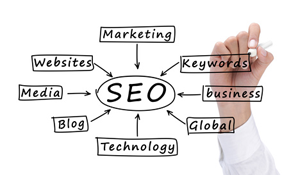 Is your current web strategy driving traffic to your website at the same speed as dial-up? The right search engine optimization strategy can take your website to the top of Googles search results. If youre just getting started with SEO, however, it can be difficult to know what works and what doesnt. When keyword density, inbound marketing, SERP, and conversion rate optimization all start to sound like alphabet soup, its tempting to throw in the towel.
Is your current web strategy driving traffic to your website at the same speed as dial-up? The right search engine optimization strategy can take your website to the top of Googles search results. If youre just getting started with SEO, however, it can be difficult to know what works and what doesnt. When keyword density, inbound marketing, SERP, and conversion rate optimization all start to sound like alphabet soup, its tempting to throw in the towel.
Dont give up! Search engine optimization does not have to be complicated and it does not have to involve mastering tricks to beat Google. In fact, any so-called SEO expert that professes knowledge of a secret keyword density formula" or other tactic is going to do your website more harm than good. Gone are the days of smoke-and-mirror tricks for SEO success.
Todays Web 2.0 demands a new set of strategies for optimizing web traffic by leveraging social media to drive website traffic. Follow these dos and donts to jump-start your websites SEO.
DO create original, relevant and creative content
Too many businesses worry about creating content that is perfectly optimized for Google, obsessing over keyword phrases and inbound marketing links. These companies fail to realize that the most search-engine-friendly content is content thats actually useful for customers. Focus your energy on publishing content that is original, relevant and creative. Your goal is to cultivate a long-lasting relationship with customers that will turn to your business as an industry authority. In short, write for customers, not Google.
DONT stuff your site with keywords or use article spin services
Old school SEO relied on smoke-and-mirror tactics like keyword stuffing and article spinning to artificially generate a high page rank. These sites manipulated Googles algorithm to rank highly in search engine results even if the content or website was irrelevant to the searchers needs. Googles Panda and Penguin algorithm updates changed this, punishing sites that use SEO tricks while rewarding sites that publish relevant, high-quality content. If you stuff your sites with keywords or use article spin services to artificially generate backlinks, you will hurt your websites rank especially if these tactics lead to a high bounce rate.
DO leverage the power of social media marketing to drive site traffic
Social networks have revolutionized the way we find, share and consume content; an active social presence is key to your businesss success. Content engagement matters. Google now includes sociability as a metric when ranking websites. Shares, tweets, likes and comments signal to Google that your content is relevant and should rank highly in search engine results. Heres how to give your site's sociability ranking a boost:
- Make sure your website is social-media friendly; include a link for quickly sharing content on Facebook, Twitter and LinkedIn
- Incentivize readers to comment on your content via social media
- Write creative headlines that prompt users to click through for an answer
- Post a link to a free eBook, white paper, or how-to article
Remember, the key to successful content sharing is creating high-quality content in the first place.
DONT let a high bounce rate sink your site
One metric Google uses when evaluating content relevancy is a sites bounce rate. A high bounce rate, indicated by a page visit that lasts less than 15 seconds, is a "red flag" that signals irrelevant or poor quality content. What does this mean for your website? If your bounce rate is high, then your page rank will be low. What if your sites content is relevant, but your bounce rate is still high? It's possible that a user interface problem is driving customers away:
- Ditch the pop-up boxes and automatic video streams; these are the equivalent of welcoming your customers by yelling in their face.
- Check site navigation: is it easy for customers to find what they need?
- Dont optimize for high-visibility keywords that have little relevance to your sites actual content
When tracking website analytics, keep an eye on your bounce rate. If it gets too high, take immediate action to correct the problem before your site gets penalized by Google.
Use these four tips to get found by your target customers and establish your company as a trusted advisor. It takes a while for Google to index your site and to develop a broad social media reach. Their is no better time to start than now!









